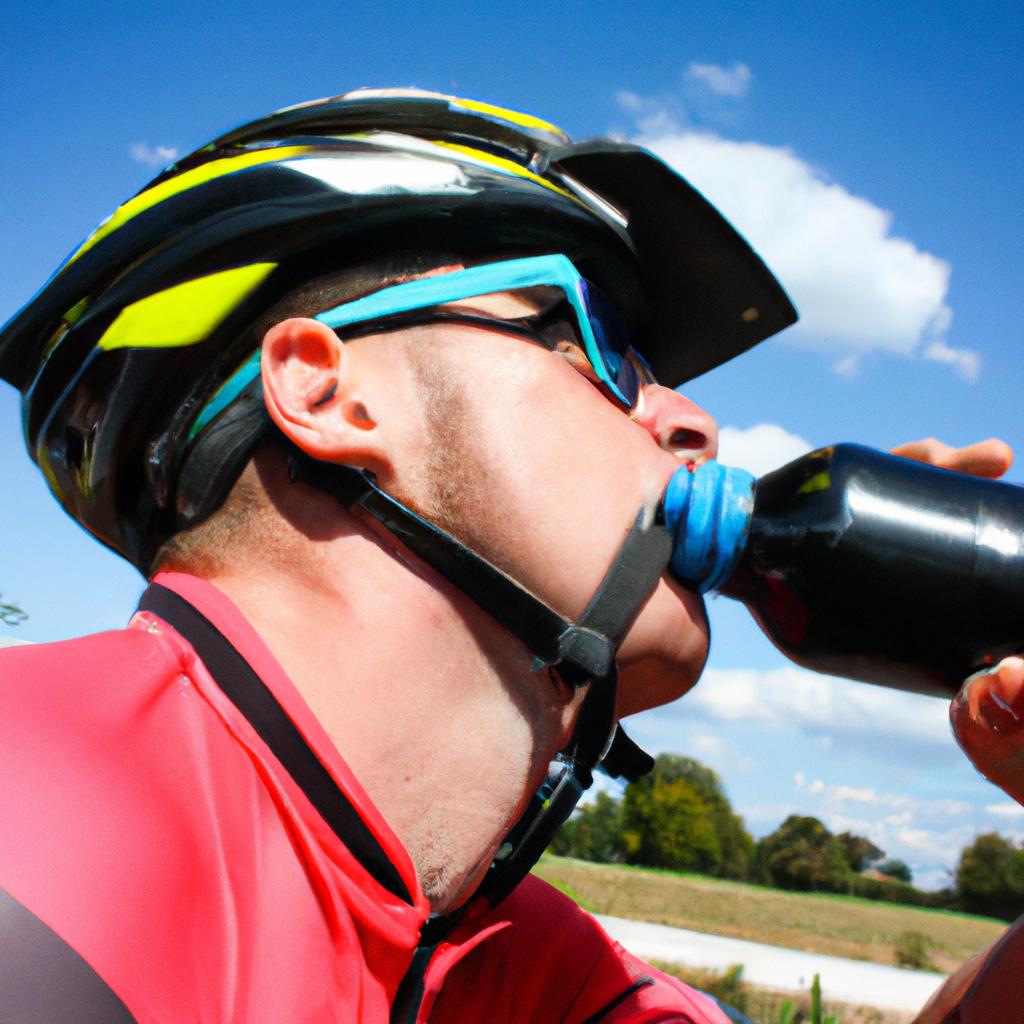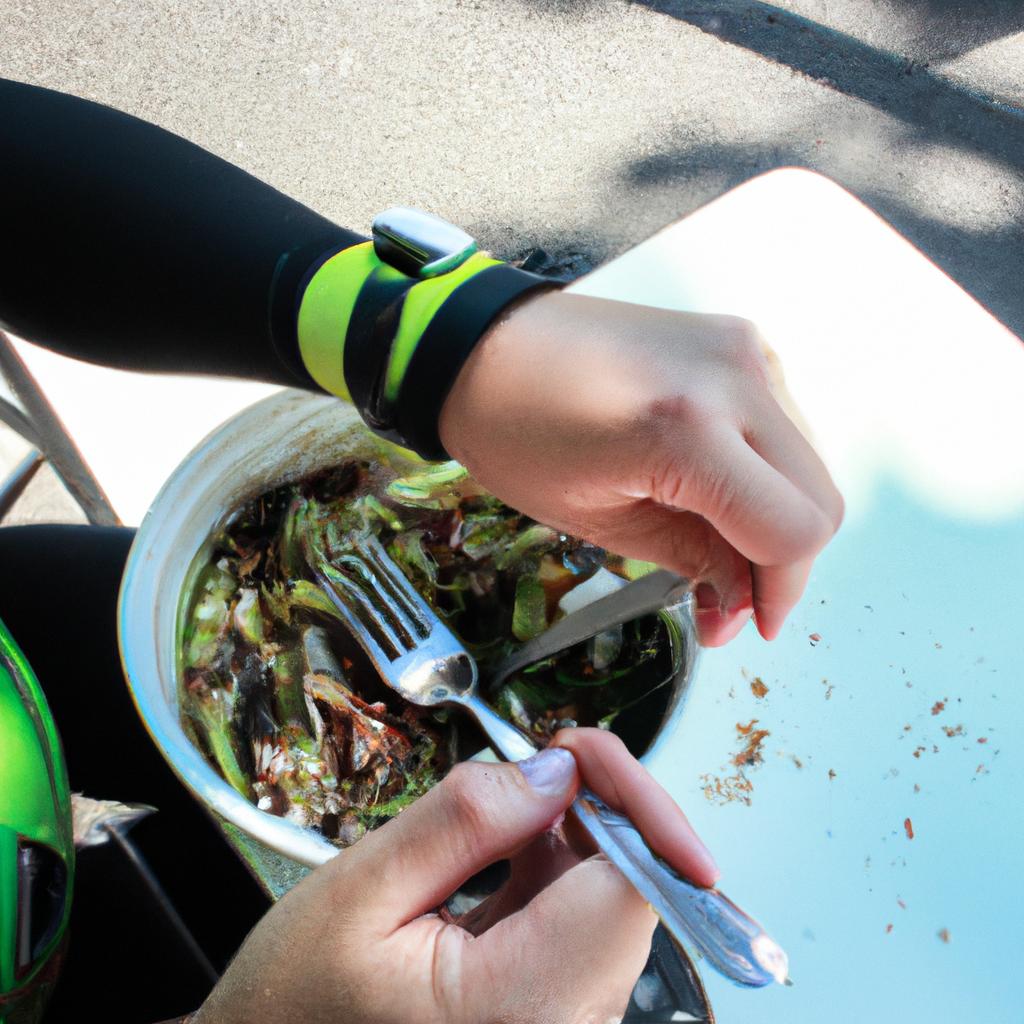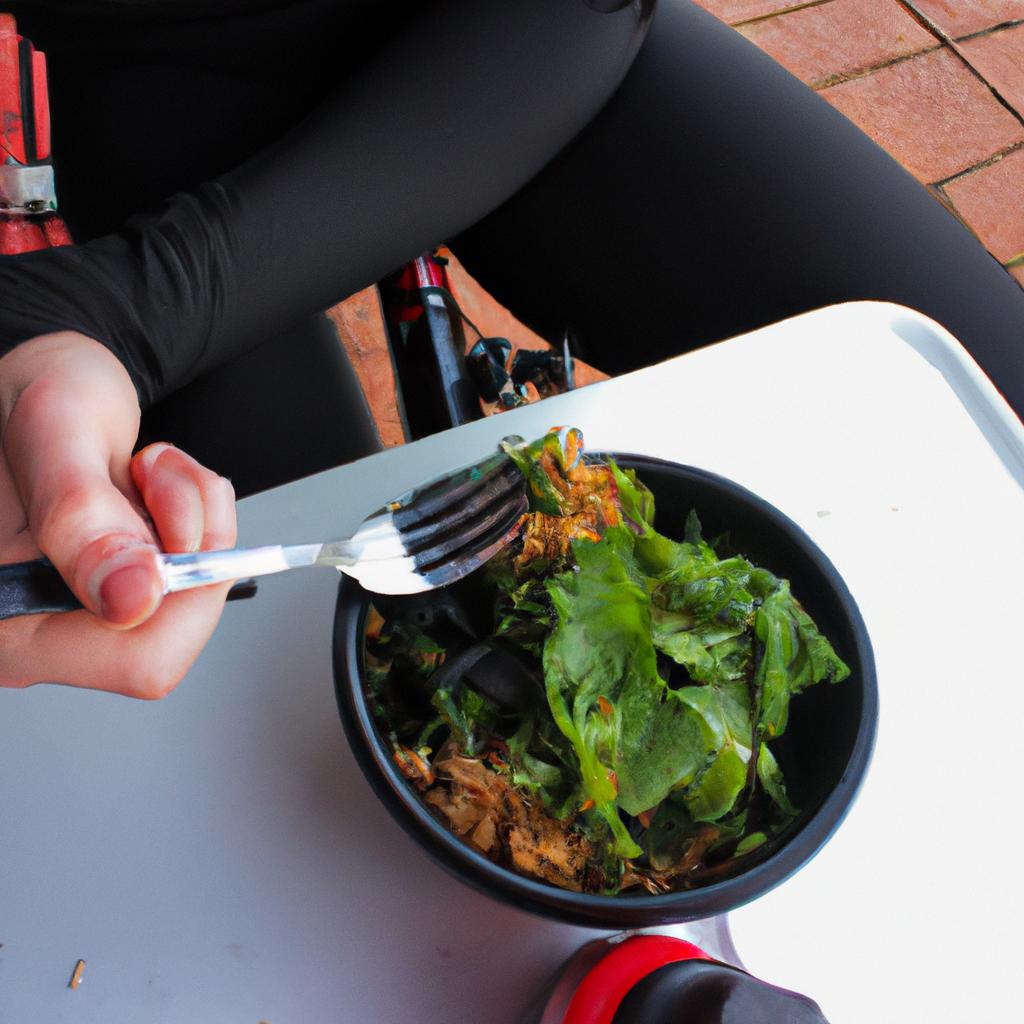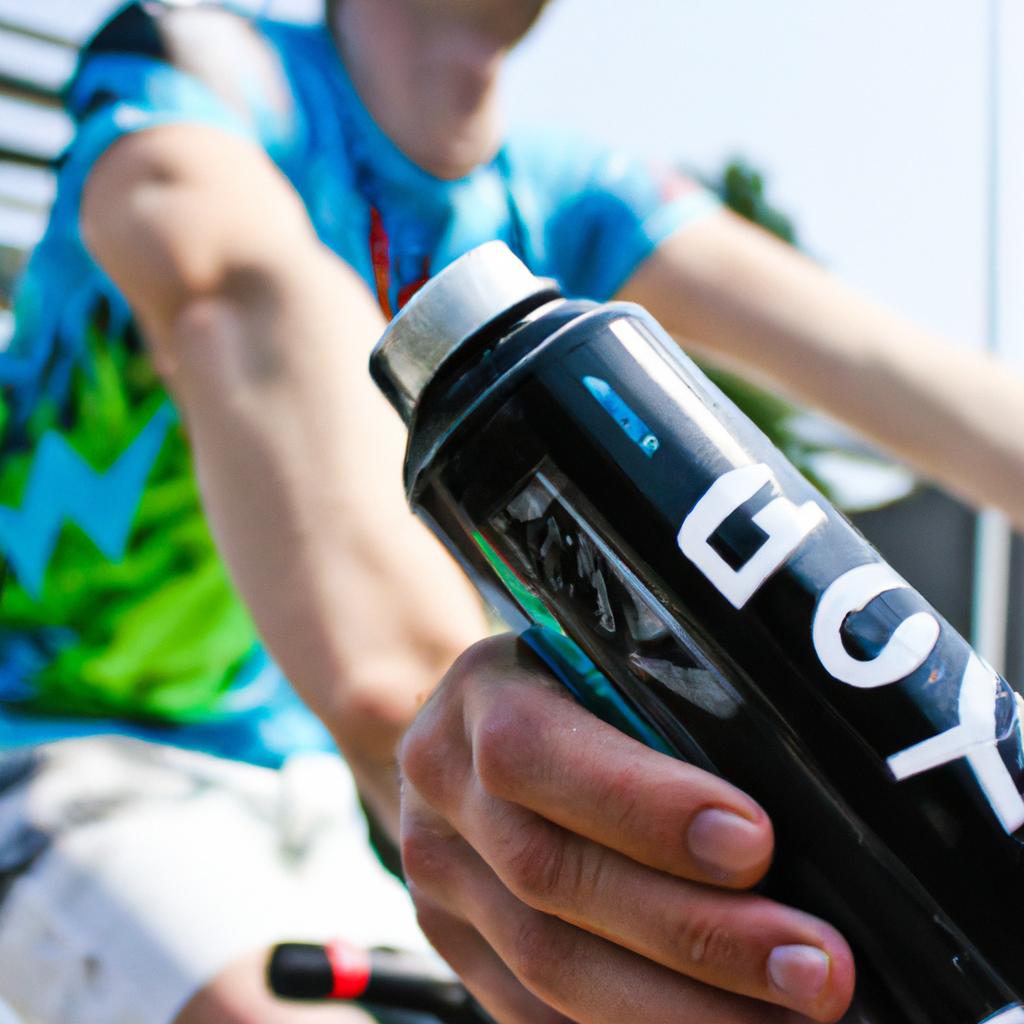Hydration Strategies for Sports Cycling: Optimal Cycling Nutrition Tips
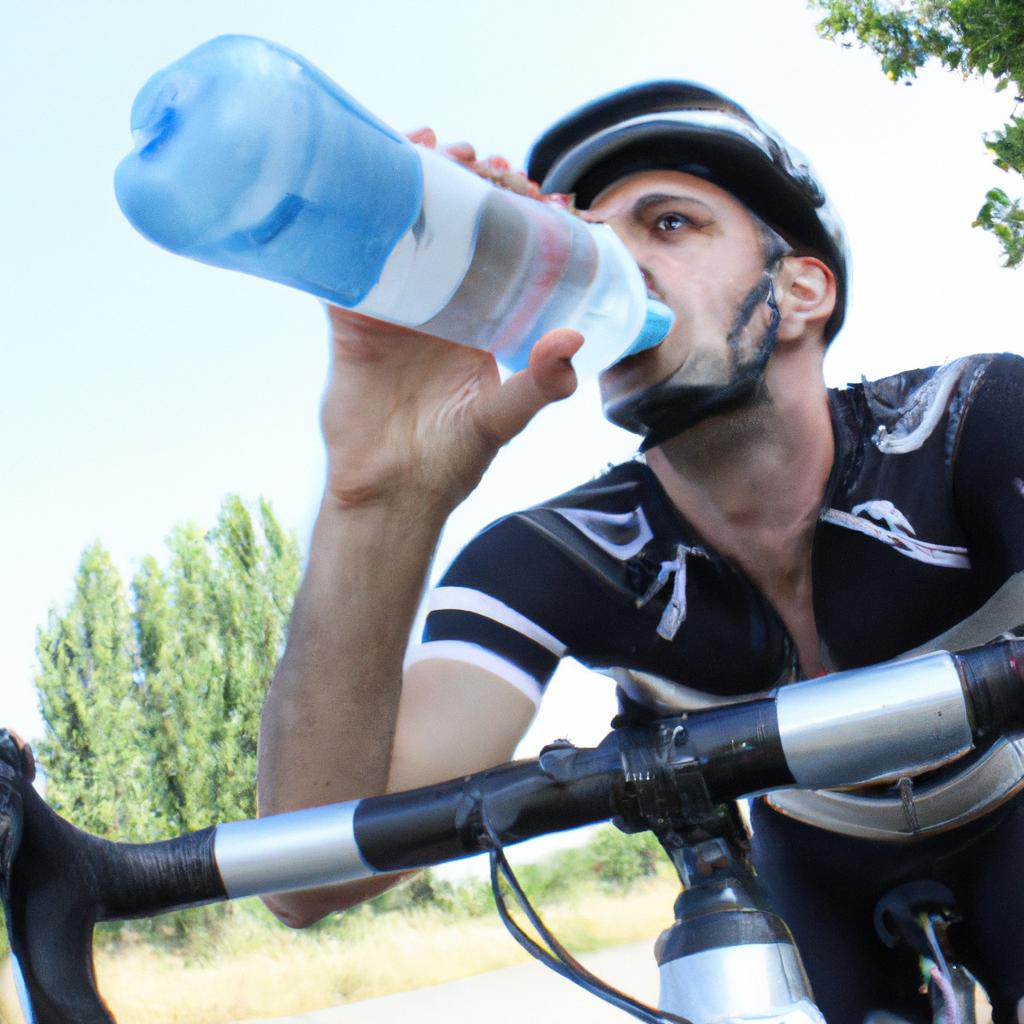
Proper hydration is essential for optimal performance in sports cycling. Whether it be a professional cyclist participating in a high-intensity race or an amateur rider tackling challenging terrains, maintaining adequate fluid and electrolyte balance can significantly impact overall performance and endurance. To illustrate the importance of hydration strategies, consider the hypothetical case of Sarah, an avid cyclist who trained rigorously but failed to implement effective hydration techniques during her races. As a result, she experienced muscle cramps and fatigue, hindering her ability to perform at her best. This article aims to explore various hydration strategies that can enhance sports cycling performance by providing cyclists with valuable nutrition tips.
The first section of this article will focus on understanding the significance of proper hydration in sports cycling. It will delve into the physiological processes involved in exercise-induced dehydration and how it affects performance. Dehydration can lead to decreased blood volume, compromised thermoregulation, impaired cardiovascular function, and reduced muscular strength and power output. By comprehending these implications, cyclists can appreciate why adopting appropriate hydration strategies is crucial for optimizing their athletic endeavors.
The subsequent section will highlight key nutritional considerations for enhancing hydration during sports cycling activities. It will discuss the role of carbohydrates, proteins, fats, and electrolytes in supporting optimal fluid absorption and replenishing electrolyte levels. Carbohydrates, in the form of sports drinks or energy gels, provide a readily available source of fuel for the muscles and aid in fluid absorption. Proteins play a role in muscle repair and recovery, while fats help to sustain energy levels during longer rides. Electrolytes such as sodium, potassium, and magnesium are crucial for maintaining proper fluid balance and preventing cramping.
The third section will outline practical hydration strategies that cyclists can implement before, during, and after their rides. It will cover aspects such as pre-hydration techniques to ensure optimal hydration status at the start of an activity, guidelines for fluid intake during cycling sessions based on individual sweat rate and environmental conditions, and post-ride recovery practices to rehydrate effectively.
Lastly, this article will address common misconceptions about hydration in sports cycling. It will debunk myths surrounding excessive water consumption, the need for specific types of beverages or supplements, as well as shed light on the importance of personalized hydration plans tailored to an individual’s needs.
By understanding the significance of proper hydration in sports cycling and implementing effective strategies, cyclists like Sarah can enhance their performance potential and minimize the risk of dehydration-related complications. With comprehensive knowledge on nutrition tips and hydration techniques specific to sports cycling, athletes can optimize their training regimens and achieve their goals with confidence.
Importance of Hydration for Cyclists
Imagine a scenario where a cyclist, let’s call him John, is participating in a grueling 100-kilometer race on a scorching summer day. As the race progresses, John starts to experience fatigue and cramps, hindering his performance. The reason behind this decline? Dehydration – an issue that many cyclists often underestimate.
Hydration plays a vital role in optimizing athletic performance and ensuring overall well-being for cyclists. When engaging in intense physical activity such as cycling, the body loses water through sweat, leading to fluid imbalance. This can result in reduced blood volume and increased heart rate, making it harder for oxygen to reach the muscles efficiently. As a consequence, endurance and power output diminish while the risk of heat-related injuries rises significantly.
To emphasize the significance of hydration further, consider these key points:
- Proper hydration improves thermoregulation: Staying hydrated helps regulate body temperature during exercise by dissipating excess heat through sweating.
- Optimal hydration enhances cardiovascular function: Sufficient fluids enable adequate blood circulation and maintain optimal blood pressure levels.
- Adequate hydration supports nutrient delivery: Water acts as a carrier for essential nutrients throughout the body, aiding muscle repair and recovery.
- Hydration aids cognitive function: Being properly hydrated promotes mental clarity and focus during long rides.
To grasp the importance of maintaining proper hydration levels while cycling, take a look at the table below which illustrates common symptoms experienced by dehydrated cyclists compared to those who are adequately hydrated:
| Symptoms of Dehydration | Symptoms of Adequate Hydration |
|---|---|
| Muscle cramps | Reduced risk of cramping |
| Dizziness | Enhanced balance |
| Fatigue | Increased stamina |
| Headaches | Improved concentration |
Recognizing the negative consequences that dehydration can have on both physical performance and general health is crucial for every cyclist. In the subsequent section, we will explore how to determine your specific hydration needs and develop effective strategies to maintain optimal fluid balance during sports cycling.
Now that we understand the importance of staying hydrated while cycling, let’s delve into determining individual hydration requirements and devising efficient strategies for maintaining proper fluid balance.
Determining Your Hydration Needs
Proper hydration is crucial for cyclists to maintain optimal performance and prevent dehydration-related issues. In the previous section, we discussed the importance of hydration in sports cycling. Now, let’s delve into determining your specific hydration needs to ensure you stay adequately hydrated during your rides.
To determine your individual hydration requirements while cycling, it is essential to consider several factors that can affect fluid loss and replenishment rates. Let’s examine these factors in detail:
-
Intensity and Duration: The intensity and duration of your cycling sessions play a significant role in how much fluid you need to consume. Longer and more intense rides result in increased sweat production, leading to higher fluid losses.
-
Environmental Conditions: The environmental conditions in which you ride also impact your hydration needs. Hotter weather and high humidity increase sweating rates, necessitating greater fluid intake to compensate for the additional moisture lost through perspiration.
-
Body Composition: Each individual has unique physiological characteristics that influence their sweat rate and fluid balance. Factors such as body weight, muscle mass, metabolism, and genetic predisposition all contribute to variations in hydration requirements among cyclists.
-
Previous Hydration Practices: Understanding your past hydration practices is crucial for fine-tuning your current strategy. Reflecting on what has worked well or caused problems in the past will help guide adjustments to optimize your future hydration plan.
Engaging Bullet Points:
- Dehydration negatively impacts both physical performance and cognitive function.
- Properly hydrating before exercise enhances endurance capacity.
- Maintaining consistent hydration throughout a ride helps regulate body temperature.
- Replenishing fluids after cycling aids in recovery and reduces post-exercise fatigue.
Informative Table:
| Factor | Effect | Recommendation |
|---|---|---|
| Intensity | Higher intensity leads to increased sweat production | Increase fluid consumption accordingly |
| Duration | Longer rides result in higher fluid losses | Consume fluids at regular intervals during the ride |
| Environmental | Hot weather and high humidity increase sweating | Drink more fluids to compensate for increased loss |
| Body Composition | Unique physiological characteristics influence needs | Adjust hydration strategy based on individual factors |
As you can see, determining your specific hydration needs involves considering various factors that contribute to fluid loss. By understanding these factors, you can develop a personalized hydration plan tailored to your requirements.
Transitioning into the subsequent section about “Best Hydration Drinks for Cycling”:
Now that we have established how crucial it is to determine your hydration needs, let’s explore the best hydration drinks specifically designed for cyclists. These beverages provide not only essential fluids but also necessary electrolytes to support optimal performance and recovery.
Best Hydration Drinks for Cycling
Determining Your Hydration Needs
Having understood the importance of staying hydrated during sports cycling, let us now delve into determining your specific hydration needs. To illustrate this, consider the following example:
Example: Imagine a cyclist training for a long-distance race in hot and humid conditions. This cyclist is aiming to complete the race within a certain time frame while maintaining optimal performance throughout.
To determine your hydration needs effectively, you should take into account several factors that influence fluid loss and requirements during cycling:
- Intensity and Duration: The intensity and duration of your rides play a crucial role in estimating how much fluid you will need. Longer and more intense sessions result in greater sweat production, leading to higher water losses.
- Environmental Conditions: Environmental conditions such as temperature, humidity levels, wind speed, and altitude affect your body’s cooling mechanisms and overall fluid balance. Hotter temperatures or high altitudes can increase sweating rates significantly.
- Body Composition: Individual variations in body composition also impact hydration needs during exercise. Factors like body weight, muscle mass, fitness level, metabolism rate, and genetic predisposition contribute to differences in sweat rates among individuals.
- Sweat Rate Measurement: Monitoring your sweat rate can help fine-tune your hydration strategy accurately. By weighing yourself before and after workouts (considering minimal clothing changes), you can calculate how much fluid you have lost per hour of exercising.
| Factors Affecting Hydration Needs | Examples |
|---|---|
| Intensity and Duration | High-intensity interval training (HIIT) sessions lasting over an hour |
| Environmental Conditions | Cycling under extreme heat or at high altitudes |
| Body Composition | Differences between two cyclists with varying weights and metabolic rates |
| Sweat Rate Measurement | Calculating the amount of fluid lost through accurate pre- and post-workout weigh-ins |
- Dehydration negatively impacts performance, endurance, and recovery.
- Overhydration can lead to hyponatremia (low blood sodium levels), causing nausea, confusion, seizures, or even coma.
- Proper hydration enhances thermoregulation and prevents heat-related illnesses during cycling.
- Understanding your individual hydration needs helps create a personalized plan that optimizes performance.
By determining your specific hydration needs, you lay the foundation for adopting an effective hydration strategy. Now let’s explore the best hydration drinks for cycling in the next section.
When and How Often to Hydrate During a Ride
Transitioning from the previous section on the best hydration drinks for cycling, let us now delve into the important consideration of when and how often to hydrate during a ride. To illustrate, imagine you are participating in a long-distance cycling event under scorching heat. You have consumed an electrolyte-rich drink before starting your ride, but as time passes, you begin to feel fatigued and notice signs of dehydration setting in. This scenario highlights the crucial role that proper hydration plays in maintaining optimal performance during sports cycling.
When it comes to hydrating during a ride, timing is key. Waiting until you feel thirsty may already indicate mild dehydration. Instead, establish a consistent schedule for drinking fluids throughout your ride. A general guideline is to consume water or electrolyte drinks every 15-20 minutes, aiming for approximately 150-250ml per intake. However, individual fluid needs vary depending on factors such as intensity level, duration of activity, body weight, and environmental conditions. Monitoring your own sweat rate can provide valuable insights regarding your specific hydration requirements.
To help ensure effective hydration during cycling sessions, consider the following tips:
- Set reminders: Use timers or smartphone apps to prompt regular fluid intake at designated intervals.
- Optimize bottle placement: Position water bottles within easy reach while riding to encourage frequent sips without disrupting momentum.
- Plan ahead: Calculate the approximate amount of fluids needed based on estimated duration and intensity of your rides.
- Experiment with flavors: If plain water becomes monotonous over longer rides, try adding natural fruit slices or low-sugar flavor enhancers to your drinks.
In addition to understanding when and how often to hydrate during a ride, it is also essential to be aware of other factors influencing hydration status. These include climate conditions (temperature and humidity), clothing choices (lightweight and moisture-wicking fabrics), personal fitness levels (which affect sweating rates), and even acclimatization strategies for extreme environments. By incorporating these considerations into your hydration plan, you can optimize your performance and minimize the risk of dehydration-related complications during sports cycling.
Transitioning smoothly to our subsequent section on “Hydration Strategies for Long Distance Cycling,” let us explore further ways to enhance your fluid intake and ensure a successful ride.
Hydration Strategies for Long Distance Cycling
Building upon the importance of proper hydration during a ride, it is essential to consider effective strategies for long distance cycling. Let’s now explore some key approaches that can optimize your hydration routine and improve performance.
To illustrate the significance of these strategies, imagine a scenario where an avid cyclist embarks on a challenging 100-mile journey under scorching summer heat. As the kilometers tick by, sweat pours down their face, and fatigue starts to set in. However, armed with appropriate hydration techniques, our cyclist is able to maintain optimal fluid levels throughout the arduous ride.
To maximize hydration efficiency during long rides like this one, cyclists should consider implementing the following strategies:
- Pre-hydration: Begin hydrating well before the ride to ensure adequate fluid stores are established.
- Fluid intake frequency: Regularly consume fluids every 15-20 minutes during the ride to replenish water lost through sweating.
- Electrolyte balance: Supplement plain water with electrolyte drinks or tablets to replace minerals lost through perspiration.
- Temperature control: Drink cool fluids rather than ice-cold ones to prevent stomach discomfort while maintaining thermoregulation.
| Strategy | Benefits |
|---|---|
| Pre-hydration | Ensures sufficient fluid reserves |
| Fluid intake frequency | Maintains consistent hydration levels |
| Electrolyte balance | Replenishes vital minerals |
| Temperature control | Prevents gastric distress and aids cooling |
By adopting these practices, cyclists can enhance their endurance and minimize dehydration-related complications during prolonged rides. Such measures not only help athletes sustain peak performance but also contribute to overall health and wellbeing.
Understanding how crucial it is to implement effective hydration strategies, we must also be aware of potential signs indicating inadequate fluid intake.
[Next section H2: Signs of Dehydration to Watch Out For]
Signs of Dehydration to Watch Out For
Transitioning from the previous section on “Hydration Strategies for Long Distance Cycling,” it is essential to be aware of the signs of dehydration that cyclists should watch out for. By recognizing these indicators, athletes can take proactive measures to prevent further complications and maintain optimal performance during their rides.
Let’s consider a hypothetical scenario: John, an experienced cyclist, embarks on a challenging 100-mile ride in hot weather conditions. Despite consuming water throughout his journey, he begins experiencing symptoms of dehydration halfway through the course. This example highlights the importance of being mindful of one’s hydration status and understanding how to identify potential warning signs.
Recognizing the signs of dehydration:
- Thirstiness: Feeling excessively thirsty indicates that your body needs more fluids.
- Dry mouth and lips: When your body lacks sufficient water, saliva production decreases, causing dryness in your mouth and lips.
- Fatigue and weakness: Dehydration can lead to decreased energy levels and muscle weakness, impairing both physical endurance and mental focus.
- Dark urine or infrequent urination: A lack of fluid intake may result in concentrated urine with a darker color than usual or reduced frequency of urination.
To help you understand the significance of proper hydration during cycling, here is a table illustrating some key consequences associated with different degrees of dehydration:
| Level | Symptoms | Consequences |
|---|---|---|
| Mild | Thirst, dry mouth | Reduced cognitive function |
| Moderate | Fatigue, dizziness | Decreased exercise capacity |
| Severe | Rapid heartbeat, confusion | Heatstroke risk |
| Life-threatening | Unconsciousness or seizures | Organ failure |
It is crucial for cyclists to listen to their bodies and respond promptly when they experience any signs of dehydration. Ignoring these signals could have serious implications not only on athletic performance but also on overall health and well-being.
In summary, recognizing the signs of dehydration is vital for cyclists to maintain optimal performance during long-distance rides. Thirstiness, dry mouth, fatigue, dark urine, and infrequent urination are all potential indicators that one should pay attention to. By being aware of these signs and understanding their consequences, athletes can take proactive measures to stay hydrated throughout their cycling endeavors.


